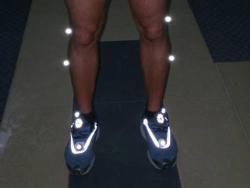Orthopaedic Sports Medicine Center of Ioannina
“A modern and fully equipped facility”
Gait Analysis: The study of Kinematic Gait Patterns
Motion analysis system from VICON (Oxford, UK) enables us to calculate kinematic parameters during a variety of movements. The calculation of these parameters is performed automatically using our system software. In this way we are able to study the mechanisms of gait disorders and their relation to musculoskeletal injuries. We also aim to study the effect of the surgical or conservative management of several orthopaedic and neurological conditions in order to improve the treatment options and offer the best final outcome to the patients.
We use an optoelectronic system with eight infra red cameras sampling at 100 Hz, positioned in a circular setup around the path of movement. Sixteen reflective markers (15mm diameter) are attached on specific bony landmarks of the subject, depending on the biomechanical model used and the subject performs a given motor task. The position of the markers during the task is recorded and the signal is then converted into a digital format for computer processing. The combination of multiple cameras provides the 3-dimensional marker coordinates. Using the musculoskeletal model and the marker coordinates we can calculate joint kinematics (angular displacement) of the main joints of the lower extremities (hip, knee, and ankle). Depending on the task that the participant performs we study the knee joint flexion-extension gait pattern or the range of motion of tibial rotation
In OSMCI we have performed significant research to quantify knee joint movement. The knee flexion-extension as well as the rotational movement patterns during gait and other activities imitating sporting activities (that include cutting and pivoting maneuvers) have been extensively studied in both ACL-deficient and ACL-reconstructed individuals. Except from aiming to find the most optimal ACL surgical reconstruction technique, this work has also produced a series of world-wide acknowledged and multi-citated published studies.
1. Kinematic gait patterns of ACL injured and reconstructed patients
We study the gait patterns of professional athletes with an ACL rupture that underwent an arthroscopic ACL reconstruction or were treated conservatively through a physical therapy rehabilitation program. We also study the gait patterns of recreational athletes or even people that do not participate to any athletic activity and sustained an ACL rupture during daily activities, motor accident e.t.c.
ACL injuries are the most common injuries to the knee. Injury to the ACL is a critical healthcare issue with considerable sporting ramifications for the young athletic population (16-45years) in which most often occurs. The incidence of the ACL rupture is supposed to be 1 / 2-3000 individuals in general population annually. This is translated into 3,000 ACL ruptures annually in Greece. ACL reconstruction is the sixth most common procedure performed in orthopaedics, and it is estimated that between 75,000 and 100,000 ACL repair procedures are performed annually in the United States alone. At the University Hospital of Ioannina at least 100 ACL reconstructions are performed annually. During the last year 70 gait analysis studies of patients before and after the ACL reconstruction were performed at the Orthopaedic Sports Medicine Center of Ioannina.
Our main purpose is to detect any modifications and adaptations of the patient's gait pattern in terms of kinematics before and after the management (surgical or conservative) of his ACL rupture. We principally focus on patients that undergo an arthroscopic ACL reconstruction. The kinematic gait patterns of such a patient are recorded one day preoperatively and also postoperatively during several time-points during the follow up period (4, 6, 9, 12 months). The patients are studied during several activities: walking on a motorized treadmill at their self-selected speed and also at greater and lower speeds, walking backwards, uphill, and downhill on the motorized treadmill, landing from a platform and perform a subsequent pivot, descending from stairs and perform a subsequent pivot.
We always evaluate the kinematic gait patterns in combination with other parameters: kinetic and EMG gait patterns, myodynamic adaptations, and of course the clinical examination of the patient are the other aspects that we study in order to have a complete portrait of the patient's functional outcome.
We study patients that have been treated with different surgical techniques, so as to conclude to the most effective ACL surgical reconstruction technique that can completely restore the normal kinematics of the knee joint and prevent the onset of osteoarthritic changes at the knee joint.
2. Kinematic gait patterns during other orthopaedic or neurological conditions
Except from studying patients that suffered an ACL injury, we also currently expanding our investigations to several other areas and thus we are also studying the gait patterns of:
-Patients that suffer other orthopaedic conditions such as subluxation of patella, total knee arthroplasty, total hip arthroplasty, and ankle sprains.
-Patients with hydrocephalus. Hydrocephalus treatment is surgical and lies on the area of neurosurgery. We estimate the patients before and after the surgical management to detect any alterations on their gait patterns during a simple walking trial on the level ground.
-Patients with cerebral palsy have been estimated in the past at the OSMCI. Especially children with spastic movement impairements caused by this condition have been estimated before and after the the use of Botox (Botulinum toxin) to relax contracting muscles.



